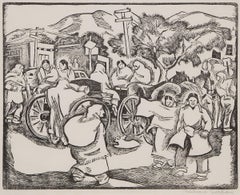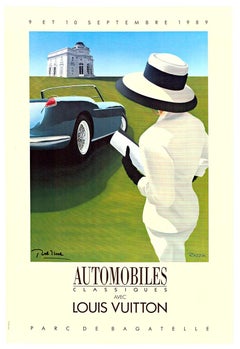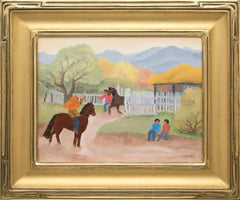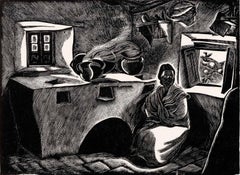Barbara Latham Art
American, 1896-1989
Beginning her career as a commercial artist, Barbara Latham travelled to Taos in 1925 seeking material for a greeting card. Serendipitously, she also found her life partner, Howard Cook, who was similarly looking for ideas for illustrations. Perhaps both were fueled in their quest by the tales of their mutual teacher, Andrew Dasburg, who knew of the energy and stimulation of this artist community. Observing local people and customs, Latham created genre scenes that offer a window into this now-vanished time and place. Her lively illustrations for numerous children’s books are a significant contribution to that graphic art in the mid-20th century.
Born in Walpole, Massachusetts, Latham’s student days included Norwich Art School and Pratt Institute in Brooklyn; but it was contact with the charismatic Dasburg at the Art Students League in Woodstock that opened her world and her view of art. Getting work with companies like Norcross Publishing and Forum magazine, she eventually made her way to Taos. Among all the spirited young artists gathered there, she met Howard Cook, who was designing illustrations for Willa Cather’s Death Comes to the Archbishop. The two married in Santa Fe and began a nomadic life together. The young couple made their way to Paris, a likely destination for modernist artists. Upon receiving a Guggenheim to study fresco painting in 1932, Cook, along with Latham, took an alternative direction and headed to Taxco, Mexico. At this time, Mexican muralists, such as Diego Rivera, were capturing the attention of progressive artists. During the Depression, both Cook and Latham aligned themselves with a populist ideal. Latham contributed work, such as Fording the Stream and Bear Family, to the American Artists Group, which was founded to produce original prints at affordable prices. When Latham settled in Taos, she was committed to an art of and for the people. Rather than a romanticized re-creation, her choice of subjects was based in common everyday activities, favoring those which brought people together. Providing a livelihood, Latham’s illustrations for children’s books reflected her heartfelt belief in the availability of art for all, and her style of open brushwork contributed to a modernist transformation of this graphic art.
After World War II, Latham experimented with Surrealism and abstraction. Many of her painted genre scenes of the fifties simplify forms in order to intensify the interplay of color and shapes. With minimal background, figures are elegantly drawn to an essence, which seems to both capture their actions and take them out of time. Riders on horses have the same linear classicism of Parthenon sculptures, and the brilliance of figure groupings separate them from the background like a frieze.
Latham and Cook had a long-lived marriage, which was grounded in keeping their creative life separate. Latham even confessed that she did not recognize some of her husband’s work upon exhibition. In 1976, the couple moved to Santa Fe, which became their final home.
©David Cook Galleries, LLCto
1
Overall Width
to
Overall Height
to
1
1
1
1
1
1
1
1
1
1
10,083
2,779
1,379
1,375
1
1
1
Artist: Barbara Latham
Barbara Latham 1950s Modernist Linocut “Saturday Morning, Taos Plaza”
By Barbara Latham
Located in Denver, CO
A vibrant celebration of Taos life and culture, Saturday Morning (Market, Taos Plaza, New Mexico) is a striking 1950s modernist linocut print by acclaimed New Mexico artist Barbara L...
Category
Mid-20th Century American Modern Barbara Latham Art
Materials
Linocut
Related Items
Original California Ferrari Louis Vuitton Parc de Bagatelle hand signed poster
By Razzia (Gérard Courbouleix–Dénériaz)
Located in Spokane, WA
Original 1989 Louis Vuitton Automobile Classiques Poster –Hand Signed, Archival Linen-Backed. This poster was created for the Concours d’Elegance ...
Category
1980s American Modern Barbara Latham Art
Materials
Lithograph
Original The French Riviera (Cote d'Azur) French Railways vintage travel poster
By Jules Cavailles
Located in Spokane, WA
Original vintage travel advertising poster for the FRENCH RIVIERA FRENCH NATIONAL RAILROADS SNCF (French National Railways) - the French Riviera. (Cote D'Azur, known as the French Riviera) The image features people looking out towards a marina full of sailing boats. Colorful artwork by the French painter Jules Cavailles (1901-1977). Printed by Perceval, Paris in 1953. Mid-Century Modern. Grade A-
This is the English version of the poster compared to the design created for Cote d'Azur. The English version is much rarer (both are rare today). The poster gives the impression of a naive painting at this Mediterranean beach and seaport.
Step into a world of timeless elegance and sunlit dreams with this exquisite French Riviera Vintage...
Category
1950s American Modern Barbara Latham Art
Materials
Lithograph
Jules CavaillesOriginal The French Riviera (Cote d'Azur) French Railways vintage travel poster, 1953
$1,498
H 39 in W 24.5 in D 0.3 in
Original Americans will Always Fight for Liberty vintage WWII (1943) poster
Located in Spokane, WA
Title: Original 1943 WWII Propaganda Poster - "Americans Will Always Fight for Liberty" - Authentic U.S. Government Issue. Archival linen-backed with the original US Government-issue...
Category
1940s American Modern Barbara Latham Art
Materials
Offset
$850
H 40 in W 28 in D 0.3 in
Original Levis's Olympic Games, Skiing North America 1980
By Michael Gibson
Located in Spokane, WA
Original Vintage Poster, Moscow 1980, Olympic Games. Levi's Skiing North America. Original first printing of this poster. Official sponsors of the US team for the 1980 Olympic Games. The campaign was titled “Levi’s Olympic Opportunity Sweepstakes," and each poster emphasized the sport associated with one of the six continents:
Great artwork depicting a sliding red skier with the globe behind, highlighting the North American continent. This poster is linen-backed and in excellent condition, ready to frame.
One of six posters produced by Levi-Strauss for the 1980 Moscow Olympic Games. The posters were created with a sport that was associated with of the six continents. Levi's logo and stylized title text in the margin below the images. Levi's commissioned FCB Advertising in San Francisco to produce a set of six posters and designed by some of the top commercial artists of the 1970s and 1980s.
The US pulled out of the Moscow Olympics due to the Soviet Union's invasion of Afghanistan. A small group of these posters was printed. Levi’s abandoned the promotions. The posters were withdrawn following the decision by US President Carter to boycott the Olympics in protest after the USSR invaded Afghanistan in December 1979. The U.S. boycott in 1980 applied to the Moscow SUMMER Olympic Games
The artists who created the Levi 1980 Olympic posters...
Category
1970s American Modern Barbara Latham Art
Materials
Offset
Harold E. Keeler, Water Fall
Located in New York, NY
Harold E. Keeler worked in Hollywood as a set designer. That seems especially important here because the Water Fall looks a little as though it could be a w...
Category
1930s American Modern Barbara Latham Art
Materials
Linocut
Original A Wonderful Opportunity for You, United States Navy 1917 vintage poster
Located in Spokane, WA
Original WW1 poster: A Wonderful Opportunity for You. Ashore, on leave. United States Navy. A pre-war recruiting lithographic poster features an ebullient sailor going home o...
Category
1910s American Modern Barbara Latham Art
Materials
Lithograph
$1,575
H 28.25 in W 20.75 in D 0.05 in
Original 1973 Vail Village Colorado vintage travel and skiing poster
Located in Spokane, WA
Original 1973 Vail Village, Colorado vintage travel and skiing poster. Preservation linen-mounted in A- condition, ready to frame.
Discover Vintage Vail Magic!
Take a trip back i...
Category
1970s American Modern Barbara Latham Art
Materials
Offset
$619
H 29.5 in W 21.5 in D 0.3 in
Original "Sabena Belgium World Airlines, Brussels vintage travel poster
Located in Spokane, WA
Original Sabena trave to Brussels; Gateway to continental Europe -- where business and pleasure begin. Sabena Belgian World Airlines. Europe...
Category
1950s American Modern Barbara Latham Art
Materials
Offset
$520 Sale Price
20% Off
H 40 in W 27 in D 0.05 in
Original 'Map of the United States as Californians See It' vintage map poster
Located in Spokane, WA
Original vintage poster: "Map of the United States as Californians See It". 1947, artist: Oren Arnold. Size: 16.5" x 20.5", R. H. MOEBUS COMPANY This poster is not linen-backed. This poster is in very good fine condition, ready to frame.
A humorous satirical pictorial map from 1947 with the golden sun on the upper left, gives a detailed depiction of California, its relative size to the rest of the United States, showing Florida as "Death Valley", the rest of the United States as "Unexplored" 'Unimportant anyway, not in California". The image has your Mexican singer; bikini-clad bathers and others set in the image. Shows rivers, lakes, harbors, landmarks, parks, recreational activities, and local people.
This map shows Los Angeles’ city...
Category
1940s American Modern Barbara Latham Art
Materials
Offset
$1,280 Sale Price
20% Off
H 16.5 in W 20.5 in D 0.04 in
Original Hawaii United Airlines vintage Hawaiiana travel poster 1967
Located in Spokane, WA
ORIGINAL 1967 United Air Lines HAWAII Travel Poster by James Jebary - Mid-Century Modern Wall Art, 25"x40"
This isn't a reprint! You're viewing a...
Category
1960s American Modern Barbara Latham Art
Materials
Offset
$698
H 40 in W 25 in D 0.2 in
Stewart Wheeler, Atlantic City (New Jersey)
Located in New York, NY
The little that is know about the painter and printmaker Stewart Wheeler indicates that most of his career was spent in Philadelphia, Pennsylvania. And...
Category
Mid-20th Century American Modern Barbara Latham Art
Materials
Screen
Original Societe Nationale des Chemin Map France, 1953 vintage poster on linen
Located in Spokane, WA
Original French vintage travel poster: "FRANCE, Société Nationale des Chemins de Fer Français." Printed in France by the French National Railroads. Original linen-backed poster; read...
Category
1950s American Modern Barbara Latham Art
Materials
Lithograph
$998
H 39.25 in W 24.5 in D 0.2 in
Previously Available Items
For a Sunday Ride (New Mexico)
By Barbara Latham
Located in Denver, CO
Original vintage oil painting by 20th century New Mexico artist, Barbara Latham (1896-1989), "For a Sunday Ride" depicts a horses and riders in an early autumn New Mexico Landscape w...
Category
20th Century American Modern Barbara Latham Art
Materials
Oil, Canvas
Our Mexican Kitchen
By Barbara Latham
Located in New Orleans, LA
Barbara Latham created this wood engraving of the kitchen in the Taxco, Mexico home she shared with her husband, artist Howard Cook. The house that Barbara and Howard Cook rented from John Evans, the son of Mabel Dodge Luhan, is shown with the Mexican cook who worked for them. It also shows the lemon tree outside their window.
Painter, print maker, and children's book illustrator Barbara Latham was born in Walpole, Massachusetts, in 1896. She was raised in Norwich, Connecticut, and studied at the Norwich Free Academy and then attended Pratt Institute from 1915 to her graduation in 1919. She then studied with Andrew Dasburg at the Art Students League's summer school in Woodstock, New York.
She spent the early part of her career in New York, where she worked for the Norcross Publishing Company and did illustrations for Forum magazine and the New York Times Sunday magazine.
In 1925, Latham went to Taos, New Mexico, for the first time to seek material for illustrations for a greeting card company. She met artist Howard Cook, who was in the process of developing illustrations for Willa Cather's Death Comes to the Archbishop. The couple married in 1927. From 1928 to 1935, they traveled widely including to Mexico; Springfield, Massachusetts; Paris; and Connecticut. In 1933, the couple made their home near Taos. In 1976, they settled in Santa Fe.
Latham created prints and paintings of New Mexico subjects: the Taos landscape, views of the town and genre scenes depicting the seasons of rural life including that of the Taos Indians. She also illustrated children's books and did pencil drawings. Latham's illustrations for children's books included those for Pedro, Nina and Perrito, 1939, and Maggie, which was chosen as one of the best books from the period of 1945 to 1950 by the American Institute of Graphic Arts. One of her paintings, Approaching Storm, c. 1930, is an expressive painting emphasizing the orange of the earth and green of trees against the dark, stormy sky. In style, the painting is a blend of the characteristics of the New Mexico landscape, the colorful approach to landscape developed by the original Taos painters...
Category
1930s American Modern Barbara Latham Art
Materials
Wood, Engraving
Bouquet, Modernist Abstract Painting Coral, Pink, Orange, Yellow, Blue, Green
By Barbara Latham
Located in Denver, CO
Bouquet is an original oil painting by 20th Century New Mexico Modernist woman artist, Barbara Latham (1896-1989), a mid-century modern abstract composition with Coral, Pink, Orange, Yellow, Blue and Green stylized flowers. Presented in a custom frame, outer dimensions measure 25 ½ x 31 ½ x 2 inches; image size is 24 x 29 ¾ inches.
Beginning her career as a commercial artist, Barbara Latham travelled to Taos in 1925 seeking material for a greeting card. Serendipitously, she also found her life partner, Howard Cook, who was similarly looking for ideas for illustrations. Perhaps both were fueled in their quest by the tales of their mutual teacher, Andrew Dasburg, who knew of the energy and stimulation of this artist community. Observing local people and customs, Latham created genre scenes that offer a window into this now-vanished time and place. Her lively illustrations for numerous children’s books are a significant contribution to that graphic art in the mid-20th century.
Born in Walpole, Massachusetts, Latham’s student days included Norwich Art School and Pratt Institute in Brooklyn; but it was contact with the charismatic Dasburg at the Art Students League in Woodstock that opened her world and her view of art. Getting work with companies like Norcross Publishing and Forum magazine, she eventually made her way to Taos. Among all the spirited young artists gathered there, she met Howard Cook, who was designing illustrations for Willa Cather’s Death Comes to the Archbishop. The two married in Santa Fe and began a nomadic life together.
The young couple made their way to Paris, a likely destination for modernist artists. Upon receiving a Guggenheim to study fresco painting in 1932, Cook, along with Latham, took an alternative direction and headed to Taxco, Mexico. At this time, Mexican muralists, such as Diego Rivera, were capturing the attention of progressive artists. During the Depression, both Cook and Latham aligned themselves with a populist ideal. Latham contributed work, such as Fording the Stream and Bear Family, to the American Artists Group, which was founded to produce original prints at affordable prices. The couple also traveled in the Deep South to the Ozarks and to “Alabama’s Black Belt.”
When Latham settled in Taos, she was committed to an art of and for the people. Rather than a romanticized re-creation, her choice of subjects was based in common everyday activities, favoring those which brought people together. Taos Pueblo was an ancient, indigenous community, and Latham’s view extended that tradition into a contemporary, multi-ethnic village. Sharing some of the spirit of WPA photographs...
Category
20th Century American Modern Barbara Latham Art
Materials
Oil, Board
Bear Family
By Barbara Latham
Located in New York, NY
Barbara Latham (1896-1988), Bear Family, 1937, wood engraving, unsigned [signed and dated in the block]. Published by American Artists Group. In excellent condition, on an ivory wove paper, the full sheet with full margins, 10 x 8, the sheet 13 x 18 inches. Window matting, with archival board, unattached mylar hinging.
A fine impression of this charming image.
The American Artists Group was formed in 1934, during the Great Depression, with the express purpose of providing unsigned inexpensive prints which were to be widely distributed. AAG published prints by Ganso, Spruance, Meissner, Ruzicka and Lankes, among many other noted artists. Although the prices of these prints was minimal, sales were sluggish in that economy and editions werenot sold out; most printingswere under 200...
Category
1930s American Realist Barbara Latham Art
Materials
Woodcut
Acequia Madre (New Mexico)
By Barbara Latham
Located in Denver, CO
Oil on canvas. Housed in a custom hand-carved gold leaf frame; outer dimensions measure 17.75 x 29.5 x 1.5 inches. Image measures 12.5 x 24.25 inches.
Provenance:
Private Collection, Colorado
About the Artist:
Beginning her career as a commercial artist, Barbara Latham traveled to Taos in 1925 seeking material for a greeting card. Serendipitously, she also found her life partner, Howard Cook, who was similarly looking for ideas for illustrations. Perhaps both were fueled in their quest by the tales of their mutual teacher, Andrew Dasburg, who knew of the energy and stimulation of this artist community. Observing local people and customs, Latham created genre scenes that offer a window into this now-vanished time and place. Her lively illustrations for numerous children's books are a significant contribution to that graphic art in the mid-20th century.
Born in Walpole, Massachusetts, Latham's student days included Norwich Art School and Pratt Institute in Brooklyn; but it was contact with the charismatic Dasburg at the Art Students League in Woodstock that opened her world and her view of art. Getting work with companies like Norcross Publishing and Forum magazine, she eventually made her way to Taos. Among all the spirited young artists gathered there, she met Howard Cook, who was designing illustrations for Willa Cather's Death Comes to the Archbishop. The two married in Santa Fe and began a nomadic life together.
The young couple made their way to Paris, a likely destination for modernist artists. Upon receiving a Guggenheim to study fresco painting in 1932, Cook, along with Latham, took an alternative direction and headed to Taxco, Mexico. At this time, Mexican muralists, such as Diego Rivera, were capturing the attention of progressive artists. During the Depression, both Cook and Latham aligned themselves with a populist ideal. Latham contributed work, such as "Fording the Stream" and "Bear Family," to the American Artists Group, which was founded to produce original prints at affordable prices. The couple also travelled in the Deep South to the Ozarks and to "Alabama's Black Belt."
When Latham settled in Taos, she was committed to an art of and for the people. Rather than a romanticized re-creation, her choice of subjects was based in common everyday activities, favoring those which brought people together. Taos Pueblo was an ancient, indigenous community, and Latham's view extended that tradition into a contemporary, multi-ethnic village. Sharing some of the spirit of WPA photographs...
Category
20th Century Folk Art Barbara Latham Art
Materials
Oil
Starting on a Rabbit Hunt
By Barbara Latham
Located in Denver, CO
Framed dimensions are 15.5 x 41.5 inches.
Complimentary Shipping within the United States. Contact us for a quote on international shipping. Same Day Shipping and expedited servic...
Category
1950s Modern Barbara Latham Art
Materials
Oil, Masonite
Barbara Latham art for sale on 1stDibs.
Find a wide variety of authentic Barbara Latham art available for sale on 1stDibs. You can also browse by medium to find art by Barbara Latham in linocut, paint, watercolor and more. Much of the original work by this artist or collective was created during the 20th century and is mostly associated with the modern style. Not every interior allows for large Barbara Latham art, so small editions measuring 14 inches across are available. Customers who are interested in this artist might also find the work of John Taylor Arms, Alfred Bendiner, and Samuel Chamberlain. Barbara Latham art prices can differ depending upon medium, time period and other attributes. On 1stDibs, the price for these items starts at $795 and tops out at $1,600, while the average work can sell for $1,198.




